Trotting For Winter Grayling
- Details
- Published on Monday, 27 November 2006 17:37
- Written by Brian Tulloch
 Unlike some anglers, I don’t look towards the end of the brown trout season with despair. Indeed, I can honestly say that I’m looking forward to the winter ahead; reason being that over the next few months my attention will turn to fishing for the majestic grayling.
Unlike some anglers, I don’t look towards the end of the brown trout season with despair. Indeed, I can honestly say that I’m looking forward to the winter ahead; reason being that over the next few months my attention will turn to fishing for the majestic grayling.
I can’t think of a better way to spend a crisp winter's day than working my way down a stretch of river in pursuit of these fantastic fish. For me there is something special about being on the river in winter, sure it’s cold and there may be a heavy frost on the ground or even snow, but I don‘t care because I know that, if I fish well, I will be rewarded with a grayling or two for my efforts. Even if I’ve not been fortunate enough to catch any, it has still been good to be on the river. I can go home contented, have a beer or two and reflect on an enjoyable day. 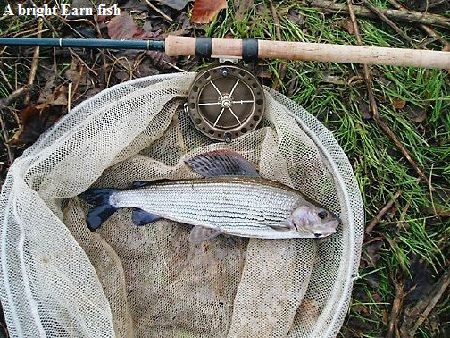
One magazine article stated that there is no point in turning up too early to fish some of our Scottish rivers because the grayling don’t stir until later on in the day. Well, I’m afraid I can't wait until the afternoon to start fishing. I’m standing on the bridge overlooking the river at first light with the frost still clinging to the ground. This is a magical time of day, the river is still untouched and it’s all mine for the taking, it’s running clear and at a favourable height, it's going to be good day I tell myself.
I set up my long trotting rod and centre pin reel. On the business end I attach a chubber type float, this is not only easy to see; it’s slim and carries plenty of weight to get the bait down to where I know the grayling will be lying. I group all of my shot together 10 inches from the size 14 hook, again this ensures that the bait gets to the bottom quickly. A couple of maggots are a good bet to begin with although I have other options should they fail to produce any offers. 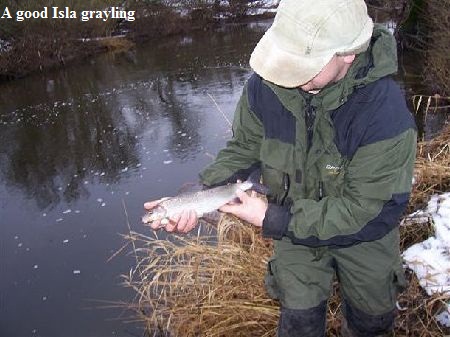
The first run is just below the bridge. It's a good looking swim, fast at the head, slowing into a deeper pool before it shallows off again. Half way down the first trot and the float disappears, I’m snagged on the bottom. It takes another trot or two down before the floats adjusted to the appropriate depth. This time it travels down nicely, only brushing the highest points of the swim. Slowing down the speed that the float fishes is easily achieved by applying gentle pressure on the rim of the centre pin with my thumb. This ensures that the bait travels in front of the float giving a better presentation. It’s not long before I’m into the first fish of the day, but it doesn’t feel like a grayling as it’s darting around all over the place. My suspicions are correct as I draw a lively trout over the net. A good trout, and one that I would be pleased to catch in the summer, but at this time of year the trout isn’t what I’m after. I carefully return her and bait up again, surely there must be grayling in this swim?
Next trot down and I momentarily stop the float where I think grayling will be lying, this lifts the bait off the bottom which I hope will induce one to take. On this occasion my theory works and I’m into a fish once more, this time it doesn’t dart around but instead it hangs out in the middle of the river using the current to its advantage. My pulse quickens as I know this must be a grayling. Once the fish tires in the shallows I get my first glimpse, yes it’s a grayling! .At an ounce or two under the pound it’s a great start to the day. I admire its beautiful colours before returning it to the water. Often when you have located one grayling more will follow, but not on this occasion. Perhaps I’ll return to the swim later in the day. Meanwhile, behind me, another opportunist feeder takes advantage of my open tub of maggots; a hungry robin helps himself to my bait, who can blame him? It’s a cold morning and food is thin on the ground, I throw him a handful of maggots before moving to the next swim.
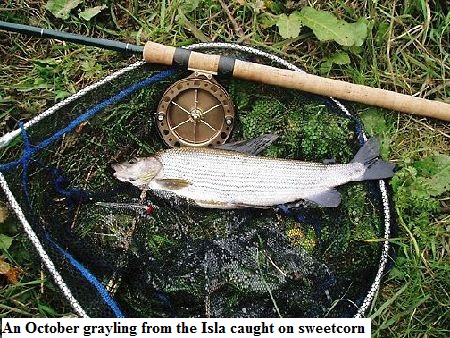 The next run I concentrate my efforts on is one of the most consistent on this stretch; frequently producing a grayling or two, not usually big fish but there in good numbers. The river is split in two by an island at this point and the grayling normally lie in the main flow, hard against the far bank. It’s a bit of a struggle to get a cast over there with the centre pin, but with a bit of practice I get the float to where I want it. As it trots down towards the end of the run the float goes down and I lift into a fish. Unfortunately the hook doesn’t hold - I’m pretty sure it was a grayling though. I bait up and try again, the float submerges at the same point and this time the fish stays on; a lovely, wee, silvery grayling of perhaps half a pound comes to the net.
The next run I concentrate my efforts on is one of the most consistent on this stretch; frequently producing a grayling or two, not usually big fish but there in good numbers. The river is split in two by an island at this point and the grayling normally lie in the main flow, hard against the far bank. It’s a bit of a struggle to get a cast over there with the centre pin, but with a bit of practice I get the float to where I want it. As it trots down towards the end of the run the float goes down and I lift into a fish. Unfortunately the hook doesn’t hold - I’m pretty sure it was a grayling though. I bait up and try again, the float submerges at the same point and this time the fish stays on; a lovely, wee, silvery grayling of perhaps half a pound comes to the net.
Another couple of fish are dropped before another grayling comes to the net, just like the last one, like peas in a pod. I suspect that grayling wise up to seeing a constant stream of maggots passing by, so a change of bait is required. The pink shrimp is my next choice, this is a simple leaded bug tying with a washed out pink seals fur body on a size 10 curved hook, on it’s day it can be deadly. A small grayling falls to its charms and another is lost before the swim goes quiet.
I recall a previous trip when I was struggling to catch any grayling. A couple of anglers were Czech nymphing on the opposite bank and were catching the odd small grayling. They told me the fly that was working for them was a pink shrimp pattern, so I changed from the maggots that I had been fishing with and put on the shrimp pattern. The next four trots down resulted in four grayling, all of them over the pound! Those grayling had totally ignored the maggots, but were more than happy to take the shrimp. That’s grayling fishing for you, nothing all day and then a short period of frantic activity. I learned a lesson that day, not to pin all your hopes on one bait, it’s always good to have options whether it be worm, sweetcorn, maggot or the shrimp. All of them have their day; sometimes they all work, sometimes none of them.
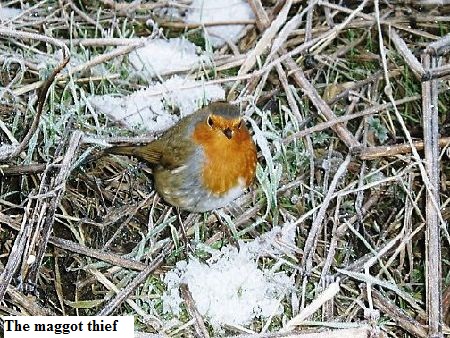 You may be thinking, why not fly fish? Well to be honest, I don’t like the idea of being waist deep in icy cold water Czech nymphing. My preference is to stay on the terra firma as much as possible at this time of year, only entering the water when it’s absolutely necessary. The main reason is that I enjoy the change; I’ve been fly fishing all year, whether it be for trout or pike, so it’s nice to do something different in the winter months. I love watching a float make it’s way downstream and then disappear when a fish takes, it’s a fantastic way to fish.
You may be thinking, why not fly fish? Well to be honest, I don’t like the idea of being waist deep in icy cold water Czech nymphing. My preference is to stay on the terra firma as much as possible at this time of year, only entering the water when it’s absolutely necessary. The main reason is that I enjoy the change; I’ve been fly fishing all year, whether it be for trout or pike, so it’s nice to do something different in the winter months. I love watching a float make it’s way downstream and then disappear when a fish takes, it’s a fantastic way to fish.
I don’t want you to get the impression that I just turn up at the river and catch fish from every swim, but then I‘m sure you don’t want to know about all the other pools and runs that I cover without success, or the annoying tangles which frequently occur trying an over adventurous cast. On really frosty days rod rings freeze up and can make fishing problematic. This is however the reality of a day's fishing - if it was too easy there wouldn’t be the same sense of achievement when it does go right. Finding grayling is rarely as easy as it sounds in books or magazine articles, at least not for me. A good way to increase your chances of success is to get to know a stretch of river well and gradually build up a picture of where grayling have been encountered before. It can save valuable time on a short winter's day if you have a rough idea where the fish might be.
It’s now afternoon and I’ve made my way down to an excellent swim at the bottom of the beat, well known for producing more than it’s fair share of good sized grayling. It’s a steady, gravelly run with the main flow running down the opposite bank. Why is it that the best runs on this stretch of river involve a longer cast? No problem with a fixed spool, but a bit more tricky if you're trying to be like John Wilson with a centre pin. In spite of these difficulties, once the right cast has been made, the centre pin offers much more control. No slack line like a fixed spool; when bites come, they can be struck instantly without any delay. In truth, a fixed spool would be easier on this run, but I get there in the end. The pool has to be searched methodically before the magic happens; it’s always important to thoroughly cover all of the water in the swim, grayling are notorious for being tightly shoaled, a cast a foot either side of the shoal will result in no fish. Eventually I find a fish along the far bank, it’s a good grayling this time and it holds itself in the current with its dorsal fin breaking the surface. It’s very much a waiting game as there’s nothing that can be done until the fish tires and comes into the shallows, Once he’s ready, I draw the net over a beautiful grayling of around a pound and a half .With his fantastic dorsal fin on display he’s a real prize, a quick snap and off he goes to fight another day. Trying to take good pictures of grayling isn’t easy, they really are wiry fish and just won’t stay still for the camera never mind trying to get them to stick out their dorsal fin for a picture. Another grayling of around a pound follows before it’s time to trudge back to the car in the failing light.
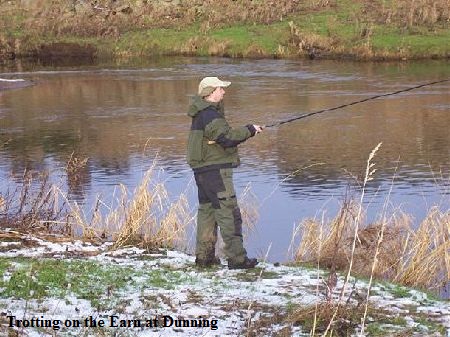 It has been a good day; I’ve caught a few grayling, perhaps I could have caught more, but I’m definitely not complaining, sometimes I don’t catch any. A good dinner and a warm bath awaits, as do those beers in the fridge. I can't wait until my next trip to the river for another encounter with the grayling, who knows maybe next time I will catch that three pounder that I dream about .
It has been a good day; I’ve caught a few grayling, perhaps I could have caught more, but I’m definitely not complaining, sometimes I don’t catch any. A good dinner and a warm bath awaits, as do those beers in the fridge. I can't wait until my next trip to the river for another encounter with the grayling, who knows maybe next time I will catch that three pounder that I dream about .

